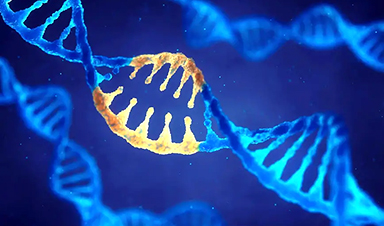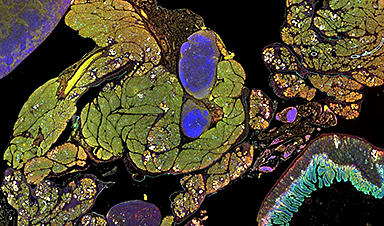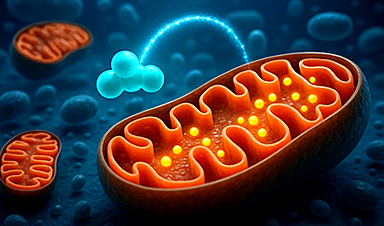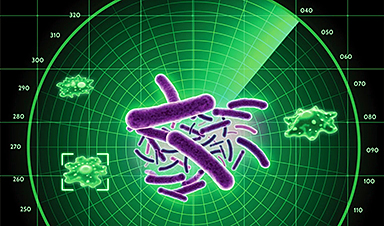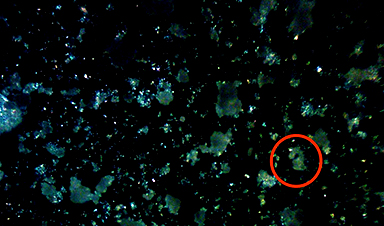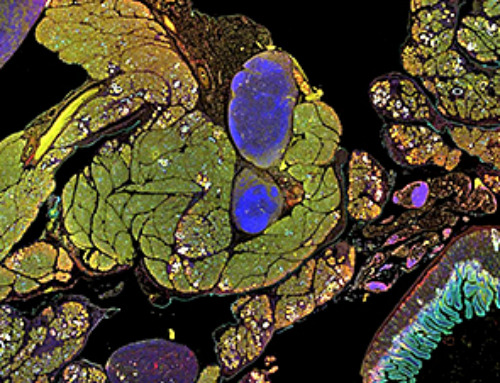Microorganisms leverage the CRISPR-Cas system as a defense mechanism against viral intrusions. In the realm of genetic engineering, this microbial immune system is repurposed for the targeted modification of the genetic makeup.
Under the leadership of Professor Dr. Alexander Probst, microbiologist at the Research Center One Health Ruhr at the Research Alliance Ruhr a research team has now discovered another function of this specialised genomic sequence: archaea – microorganisms that are often very similar to bacteria in appearance – also use them to fight parasites.
The team has recently published their findings in Nature Microbiology.

Dr. Alexander Probst. Credit: UDE/Bettina Engel-Albustin
Biochemists Emmanuelle Charpentier and Jennifer Doudna received the Nobel Prize for the biotechnological application of the CRISPR-Cas systems, or ‘genetic scissors’, for genetic engineering in 2020. However, many functions of this genetic tool are still unexplored to date. Could microorganisms, for example, use them to fight off other microorganisms that live on them as parasites?
With this research question in mind, Alexander Probst analyzed the genetic material of microbes in the Earth’s deep crust. ‘More than 70 percent of the Earth’s microorganisms are housed in the deep biosphere. If we want to understand diversity on our planet, it is worth taking a look into the deep’, he explains.
With his team, the microbiologist has analyzed the water that a geyser in the USA spits to the surface from the depths, as well as samples from the Horonobe underground laboratory in Japan. The research team focused on archaea, which live in the ecosystem as hosts and parasites. The tiny microbes are highly similar to bacteria in cell size but have substantially different physiological properties.
The result of their genomic analysis provided new insights: there were conspicuously few parasites in the vicinity of the hosts, and the hosts showed genetic resistance to the parasites. The researchers discovered the reason for this in the genetic scissors in the genome of the microorganisms. ‘In the course of evolution, the archaea have incorporated the parasitic DNA. If a parasite with the same DNA now attacks the organism, the foreign genetic material is probably recognized by the CRISPR system and presumably decomposed’, Probst explains. The microbiologist is an expert in the analysis of genetic material from environmental samples and uses the latest methods in his lab, such as Oxford Nanopore technology, which enables rapid and comprehensive sequencing of the material.
In order to rule out the possibility that they have only come across isolated cases, the researchers have extended the analysis to over 7,000 genomes and observed the phenomenon very frequently. In future research, this finding will also facilitate distinguishing between beneficial symbionts and harmful parasites. If there has been a CRISPR recognition, the microorganism is very likely to be a parasite. This will probably also help better understand important metabolic processes, such as the carbon flow in ecosystems, in the future.
Reference: “A predicted CRISPR-mediated symbiosis between uncultivated archaea” by Sarah P. Esser, Janina Rahlff, Weishu Zhao, Michael Predl, Julia Plewka, Katharina Sures, Franziska Wimmer, Janey Lee, Panagiotis S. Adam, Julia McGonigle, Victoria Turzynski, Indra Banas, Katrin Schwank, Mart Krupovic, Till L. V. Bornemann, Perla Abigail Figueroa-Gonzalez, Jessica Jarett, Thomas Rattei, Yuki Amano, Ian K. Blaby, Jan-Fang Cheng, William J. Brazelton, Chase L. Beisel, Tanja Woyke, Ying Zhang and Alexander J. Probst, 27 July 2023, Nature Microbiology.
DOI: 10.1038/s41564-023-01439-2
News
Studies detail high rates of long COVID among healthcare, dental workers
Researchers have estimated approximately 8% of Americas have ever experienced long COVID, or lasting symptoms, following an acute COVID-19 infection. Now two recent international studies suggest that the percentage is much higher among healthcare workers [...]
Melting Arctic Ice May Unleash Ancient Deadly Diseases, Scientists Warn
Melting Arctic ice increases human and animal interactions, raising the risk of infectious disease spread. Researchers urge early intervention and surveillance. Climate change is opening new pathways for the spread of infectious diseases such [...]
Scientists May Have Found a Secret Weapon To Stop Pancreatic Cancer Before It Starts
Researchers at Cold Spring Harbor Laboratory have found that blocking the FGFR2 and EGFR genes can stop early-stage pancreatic cancer from progressing, offering a promising path toward prevention. Pancreatic cancer is expected to become [...]
Breakthrough Drug Restores Vision: Researchers Successfully Reverse Retinal Damage
Blocking the PROX1 protein allowed KAIST researchers to regenerate damaged retinas and restore vision in mice. Vision is one of the most important human senses, yet more than 300 million people around the world are at [...]
Differentiating cancerous and healthy cells through motion analysis
Researchers from Tokyo Metropolitan University have found that the motion of unlabeled cells can be used to tell whether they are cancerous or healthy. They observed malignant fibrosarcoma [...]
This Tiny Cellular Gate Could Be the Key to Curing Cancer – And Regrowing Hair
After more than five decades of mystery, scientists have finally unveiled the detailed structure and function of a long-theorized molecular machine in our mitochondria — the mitochondrial pyruvate carrier. This microscopic gatekeeper controls how [...]
Unlocking Vision’s Secrets: Researchers Reveal 3D Structure of Key Eye Protein
Researchers have uncovered the 3D structure of RBP3, a key protein in vision, revealing how it transports retinoids and fatty acids and how its dysfunction may lead to retinal diseases. Proteins play a critical [...]
5 Key Facts About Nanoplastics and How They Affect the Human Body
Nanoplastics are typically defined as plastic particles smaller than 1000 nanometers. These particles are increasingly being detected in human tissues: they can bypass biological barriers, accumulate in organs, and may influence health in ways [...]
Measles Is Back: Doctors Warn of Dangerous Surge Across the U.S.
Parents are encouraged to contact their pediatrician if their child has been exposed to measles or is showing symptoms. Pediatric infectious disease experts are emphasizing the critical importance of measles vaccination, as the highly [...]
AI at the Speed of Light: How Silicon Photonics Are Reinventing Hardware
A cutting-edge AI acceleration platform powered by light rather than electricity could revolutionize how AI is trained and deployed. Using photonic integrated circuits made from advanced III-V semiconductors, researchers have developed a system that vastly [...]
A Grain of Brain, 523 Million Synapses, Most Complicated Neuroscience Experiment Ever Attempted
A team of over 150 scientists has achieved what once seemed impossible: a complete wiring and activity map of a tiny section of a mammalian brain. This feat, part of the MICrONS Project, rivals [...]
The Secret “Radar” Bacteria Use To Outsmart Their Enemies
A chemical radar allows bacteria to sense and eliminate predators. Investigating how microorganisms communicate deepens our understanding of the complex ecological interactions that shape our environment is an area of key focus for the [...]
Psychologists explore ethical issues associated with human-AI relationships
It's becoming increasingly commonplace for people to develop intimate, long-term relationships with artificial intelligence (AI) technologies. At their extreme, people have "married" their AI companions in non-legally binding ceremonies, and at least two people [...]
When You Lose Weight, Where Does It Actually Go?
Most health professionals lack a clear understanding of how body fat is lost, often subscribing to misconceptions like fat converting to energy or muscle. The truth is, fat is actually broken down into carbon [...]
How Everyday Plastics Quietly Turn Into DNA-Damaging Nanoparticles
The same unique structure that makes plastic so versatile also makes it susceptible to breaking down into harmful micro- and nanoscale particles. The world is saturated with trillions of microscopic and nanoscopic plastic particles, some smaller [...]
AI Outperforms Physicians in Real-World Urgent Care Decisions, Study Finds
The study, conducted at the virtual urgent care clinic Cedars-Sinai Connect in LA, compared recommendations given in about 500 visits of adult patients with relatively common symptoms – respiratory, urinary, eye, vaginal and dental. [...]
